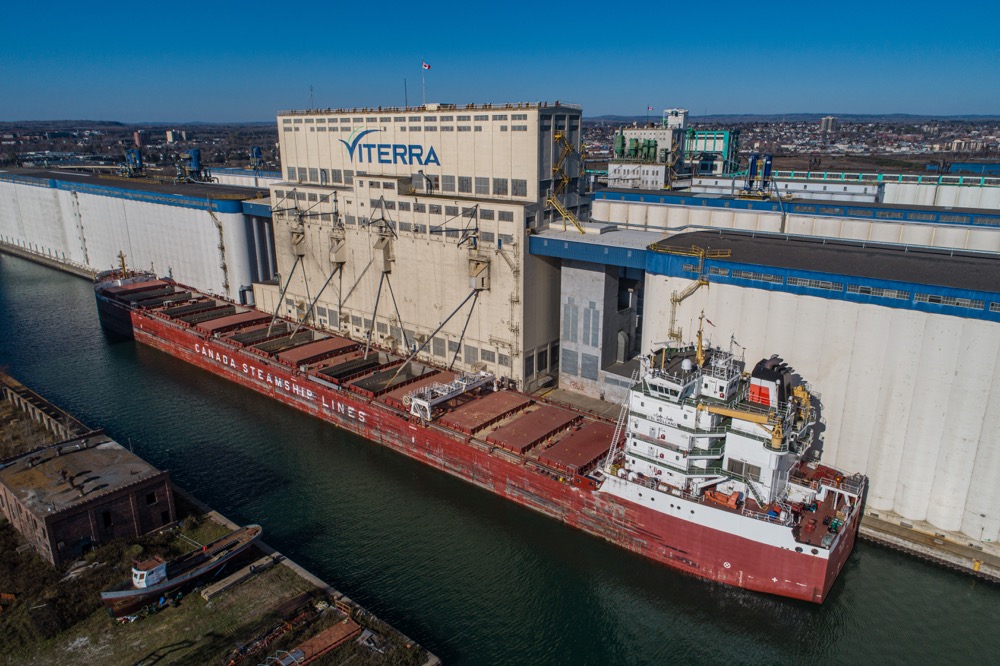Canadian Great Lakes ports posted lower overall tonnage shipments during March and April due in part to ice conditions and less available Prairie grain for export. However, road salt, Ontario corn and soybeans, Prairie potash and steel imports were strong performers.
Ice conditions in Lake Superior in the early part of the season hampered ship traffic to some ports; while Canadian grain shipments via the St. Lawrence Seaway were down 26 per cent due to a smaller Prairie harvest last year. There were robust opportunities in other areas, however, with U.S grain being up by 175 percent along with steel coil and iron imports up 24 per cent compared to 2021. Road salt shipments were also up 21 per cent, as Canadian mines delivered to cities throughout the bi-national region.
“It’s still very early in the season to make many predictions,” said Terence Bowles, President and CEO of The St. Lawrence Seaway Management Corporation. “We expect that there will be ongoing fluctuations in commodity pricing, supply and demand due to global logistical and product challenges, economic conditions and the Russian/Ukraine conflict. The Great Lakes-St. Lawrence shipping corridor is well positioned to pivot as necessary and will play an important role in helping to alleviate shortages of fertilizer and grain due to the devastating war in Ukraine.”
Overall cargo shipments (from March 22 to April 30) via the St. Lawrence Seaway totaled 3.5 million metric tons, down by 18 per cent compared to the same period in 2021. All grain was down 15 per cent at 997,000 tons, general cargo down 31 per cent at 282,000 tons, iron ore down 23 per cent at 591,000 tons, dry bulk down 10 per cent at 1,081,000 tons.
At the Port of Windsor, overall year-to-date tonnage is down by 15 per cent, mainly due to a slower start to grain and aggregate shipments. “A late blast of cold in Northern Ontario resulted in frozen aggregates/sand pits and jammed ice flows at the beginning of the season that slowed shipping traffic,” said Patricia Leblanc-Jaeger, Director Finance & Administration, Port Windsor.
General cargo shipments at the port, however, continued to outperform. More than 14,300 metric tons of steel have been delivered up to the end of April, double that of the same period in 2021. Much of this will be used in construction projects. Cement has also been delivered for construction of the Gordie Howe International Bridge with more expected in the coming season.
At the Port of Thunder Bay, the momentum in potash shipments experienced late in the 2021 shipping season has continued in 2022. Potash shipments at the port increased by 93 per cent in 2021. More than 90,000 metric tons of potash, an important ingredient in fertilizer, were loaded outbound this April, the highest tally for that month since 2007. Thunder Bay is the only export port on the Great Lakes for potash.
The Port of Hamilton is enjoying some sweet news, with sugar refinery Sucro Can announcing it will more than double its refinery capacity to meet the growing demand of Ontario food manufacturers. This new expansion will see capacity reach 200,000 metric tons by 2024. “Sucro Can is located at the Port of Hamilton’s Pier 10, where HOPA has cultivated a cluster of agri-food related businesses, supporting the region’s $1 billion-and-growing food processing industry,” said Ian Hamilton, President & CEO of HOPA Ports.
Though overall tonnage results for Hamilton port have been slightly less in the first month, the port has seen over 1 million metric tons of cargo already with grain seeing an increase of 34 per cent compared to the same time last year. Ontario corn and soybeans, which had good harvests in 2021, are being shipped to Europe.
Oshawa is off to a very strong start as the port has seen more than double the amount of cargo; led by cement, steel and salt. (photo Port of Thunder Bay)





